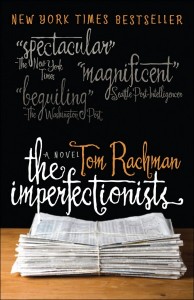Rachman, Tom. (2010). The Imperfectionists. New York: Random House/Dial.
This New York Times “Notable Book” has an interesting marketing angle. Its cover and first few inside pages contain hyperbolic praise from newspaper book reviewers, while the book itself is a sympathetic treatment of people who work at a newspaper. It reminds me of that documentary film about product placement in movies, financed entirely by product placements.
Marketing strategy aside, The Imperfectionists is an interesting read on its own merits. It comprises a dozen or so short chapters, each of which vignettes a character who works at a contemporary English-language newspaper published in Rome. There are chapters about the copy editor, the fact-checker, the editor-in-chief, the publisher, various reporters, and so on. The relatively independent vignettes are loosely tied together by interactions among the characters, such as office romances, hiring and firing decisions, and by the gradual decline of the newspaper as circulation falls off (oddly, no mention is made of advertising sales or revenue.)
Short, three-page chapters in italics are interspersed, to let the omniscient, third-person narrator tell what happens to the newspaper and its ownership over time, independent of the characters’ exertions.
There is no real dramatic tension in the larger newspaper story. Over several generations of publishers, the paper inexorably declines and is eventually shuttered. No surprise there. But the individual character stories are well written, especially in the first third of the book. In each chapter, the main character has a particular psychological vulnerability, a desperate need that drives the character in everything he or she does, but the character is not fully aware of that need, and in fact may have a completely different, even delusional self-assessment, which results in interesting, conflicted behavior. It is the classic Aristotelian hamartia.
For example, one character is a formerly successful free-lance reporter for the paper in Cairo, but hasn’t sold a story in years and is seriously broke as old age approaches. He still thinks of himself as an important success, but can only manage lame features, not hard news any more. Also, he is extremely lonely, and estranged from his adult son, and desperately wants to reconnect with him. He pretends he can look out for the son, teach him the ropes, and so on, while the son, for his part, realizes the father needs help. The complexities of that relationship are expertly drawn and expressed.
Other vignettes involve unrequited love, unrecognized character disorders, self-blinding arrogance, incredible naivety, and many other human imperfections. Each main character has a fundamental flaw that makes his or her life interesting to read about. Most are not quite unreliable characters, but rather, simply “imperfect” ones. This trick of characterization is one that every writer needs to learn, and there could be no better illustration of its effectiveness than this book. The writing is excellent, the diction is high, the humor droll, and the characters well-rendered.
Unfortunately, every chapter trots out this one-trick pony, and after five or six shows, the exercise gets stale. In addition, the best vignettes are the first half-dozen, and after that, many of the characters’ “imperfections” are so obvious and rendered with such a heavy hand that the characters become two-dimensional, implausible, and uninteresting. It is as if the author ran out of interesting characterological imperfections to explore, or did not take the time to explore them fully. But overall, I think the first third of the book is worth the cover price.

